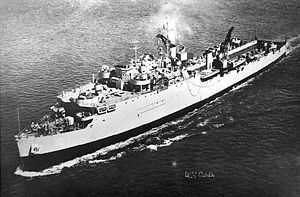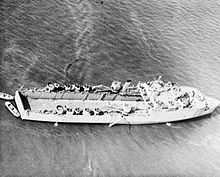Casa Grande-class dock landing ship
 | |
| Class overview | |
|---|---|
| Name: | Casa Grande |
| Builders: |
Newport News Boston Navy Yard Gulf Shipbuilding Philadelphia Naval Yard |
| Operators: |
|
| Preceded by: | Ashland-class dock landing ship |
| Succeeded by: | Thomaston-class dock landing ship |
| Planned: | 19 |
| Completed: | 17 |
| Cancelled: | 2 |
| Retired: | 17 |
| General characteristics | |
| Type: | dock landing ship |
| Displacement: | 4,032 tons (light) 7,930 tons (seagoing) |
| Length: | 454 ft (138 m) at waterline 457 ft 9 in (139.52 m) oa |
| Beam: | 72 ft 2 in (22.00 m) |
| Draught: | 15 ft 10 in (4.83 m) |
| Propulsion: | 2-shaft turbines, 2 boilers 7,000 shp (LSD13-21 and 25-27) 9,000 shp (LSD22-24) |
| Speed: | 15.6 knots (18.0 mph; 28.9 km/h) |
| Range: | 7,400 nmi (13,700 km) at 15 kn (28 km/h) |
| Boats and landing craft carried: | One of the following arrangements: |
| Capacity: | 1,500 tons of cargo (if not carrying boats) |
| Complement: | 17 officers and 237 men |
| Armament: | 1 × 5"/38 guns 12 × 40 mm Bofors guns (2 × 2), (2 × 4) |
The Casa Grande class was a class of dock landing ships used by the Royal Navy and the United States Navy during the Second World War. Nineteen ships were planned, but two, USS Fort Snelling and USS Point Defiance were cancelled before being completed.
Design
The 'Landing Ship Dock' or LSD developed from a British staff requirement for a type of self-propelled drydock to transport beaching craft over long distances, that would in turn deliver trucks and supplies onto the beach.[1] A flooding deck aft capable of holding either two of the larger British Landing craft tanks (LCTs) or three of the new US LCTs was included in the designs.[1] With the option of fitting extra decks, large numbers of vehicles could be transported, and loaded into landing craft via ramps. Despite an initial specification for a speed of 17 knots (20 mph; 31 km/h), the LSDs were capable of only 15.6 knots (18.0 mph; 28.9 km/h).[1]
Service
The British initially ordered seven of the class from US dockyards, numbered LSD-9 to 15.[1] Only four were delivered, numbers 9 to 12, while 13 to 15 were retained by the US Navy, which ordered another twelve to the design, but only built ten.[1][2] In total thirteen of the ships served with the US Navy, while four ships served with the Royal Navy.[1]
Ships

Royal Navy
- HMS Eastway (F140)
- HMS Highway (F141)
- HMS Northway (F142)
- HMS Oceanway (F143)
US Navy
- USS Casa Grande (LSD-13) (ex-HMS Portway, ex-Spear)
- USS Rushmore (LSD-14) (ex-HMS Swashway, ex-Sword)
- USS Shadwell (LSD-15) (ex-HMS Waterway, ex-Tomahawk)
- USS Cabildo (LSD-16)
- USS Catamount (LSD-17)
- USS Colonial (LSD-18)
- USS Comstock (LSD-19)
- USS Donner (LSD-20)
- USS Fort Mandan (LSD-21)
- USS Fort Marion (LSD-22)
- USS Fort Snelling (LSD-23) (cancelled, completed as USNS Taurus (T-AK-273))
- USS Point Defiance (LSD-24) (cancelled)
- USS San Marcos (LSD-25)
- USS Tortuga (LSD-26)
- USS Whetstone (LSD-27)
Spanish Navy
Spanish ship Galicia (L-31), ex-USS San Marcos (LSD-25)
Greek Navy
Greek ship Okeanos (ex-HMS Oceanway (F143))
French Navy
French ship Foudre (ex-HMS Oceanway (F143), ex-Greek ship Okeanos)
Republic of China Navy
ROCS Chung Cheng (LSD-191) (ex-USS Comstock (LSD-19))
Notes
References
- Colledge, J. J.; Warlow, Ben (2006) [1969]. Ships of the Royal Navy: The Complete Record of all Fighting Ships of the Royal Navy (Rev. ed.). London: Chatham Publishing. ISBN 978-1-86176-281-8. OCLC 67375475.
- Gardiner, Robert; Chesneau, Roger (1980). Conway's All the world's fighting ships, 1922–1946. Conway. ISBN 0-85177-146-7.
- Jane's Fighting Ships of World War Two. New York: Crescent Books. 1996 [1989]. ISBN 0-517-67963-9.
External links
| Wikimedia Commons has media related to Casa Grande class dock landing ships. |
- Casa Grande class at Uboat.net
- "Mother of Minesweepers." Popular Mechanics, February 1952, pp. 97-104.
| ||||||||||||||||||||||||||||||||||||||||||||||||